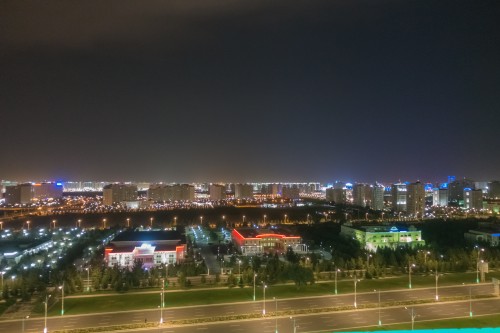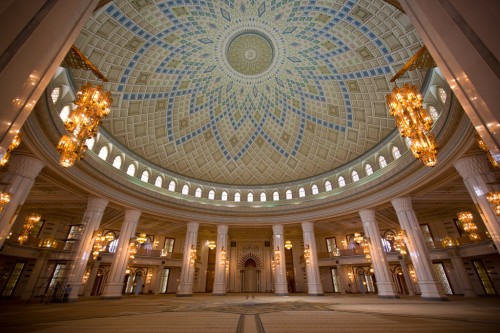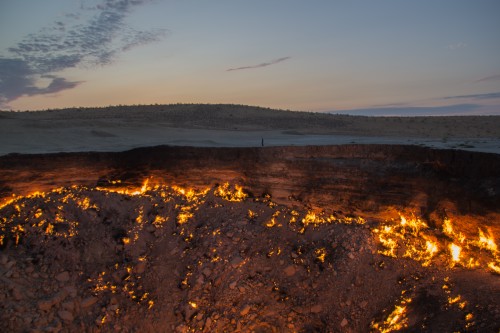
Our flight landed in Ashgabat around 2am. It is a newly remodeled airport, and extremely nice. We had read about it on the web when it opened a year ago, and there's not really anything like it out there. We had a jetway tonight, and in the terminal there were white ornate columns everywhere, and plenty of LED lights to make it bright. The airport was totally empty, it was just our flight. We failed at the immigration counter, as even though we had our visa, we didn't have a bank receipt. We eventually figured this out when the person kept saying "bank receipt" and then handed us our passports back. So we walked around until we found the bank, paid our $14 each, then took that receipt back to immigration.
 |
It worked this time, at least for Justin. They asked Crystal about where we were staying, but she didn't have that information handy (it was in one of the bags Justin had, and frankly we hadn't bothered to look since we were on a tour). At customs, they did a thorough review of our bags, particularly the camera bag, and asked about some of our vitamins. We had read they don't allow opioids or pseudoephedrine, so we actually tossed our Sudafed in Iran. This search was making us thankful we'd thrown away the Sudafed, and thank goodness we hadn't needed it either. Seemingly every person we saw asked to see our passports and Visa. No one could find the Visa in Justin's passport, they kept turning past it. He wanted to show them, but didn't want to interfere, either. We finally made it out, after about an hour of this crap - not the most welcoming beginning. The only place we'd felt less welcome was at LAX a few years ago, coming back from a trip.
We met Tore (pronounced Tor-ay) just outside all of this madness, and quickly hopped into a van to head to our hotel for a few hours. We were excited to see the airport from the outside, and disappointed when Tore told us we couldn't take pictures of the airport. [There's this thing called the internet, however, that has plenty of photos, including this one.] We found out there is a litany of places that you can't take photos in Turkmenistan - the airport, any military place, any Presidential palace, the local bazaars, many government buildings. Of these, the military installations seem reasonable, but everything else seems odd. Tore told us that they would check pictures when we left the country, and that we didn't want anything that would make them do a full bag search. He didn't need to tell us twice.
 |
 |
The road was in great shape, basically perfect. There were also large fountains and lights everywhere. There were also dozens if not hundreds of brand new buildings, and the buildings were lit up, with lasers shining on them to make "galloping" horses. Mind you, this was at 3 in the morning. We got to the hotel at 3:30 am. Tore mentioned that this used to be the Presidential hotel, and that the neighborhood (Arcabil, pronounced Arch-a-beel) is new. Tore also asked if we had all the extra pictures we needed - we had no clue what he was talking about, but thankfully he said we could work it out in the morning. They put us on the 12th floor, and the room - like the exterior, lobby, elevator, and everything else - was both seemingly perfect yet also unnerving since it seemed completely empty and soulless. Check out the Tripadvisor reviews, they largely mimic our experience. When we finally got settled in the room, Justin asked Crystal (in a quiet whisper) if she thought the room was bugged; equally serious and joking, and she didn't take it as a joke either.
 |
 |
We did manage to get to sleep easily, as the bed was very comfortable. We woke up at 8:30 and checked out the view - there was no more activity than at 3:30. The whole city looked to be a ghost town. Besides being completely empty, the city reminded us of Las Vegas - an oasis in the middle of desert. We skipped a shower, so that we could take one when we came back, just before leaving for Darvaza, since there would be no shower available there. Downstairs, we realized that this massive hotel was completely empty. There were 100 tables in the restaurant, and only 1 other table occupied. We had Continental and Chinese breakfast options, and they were fine, but not great. The Russian waitress was nice enough, but stopped by only once even though there was no one else to wait on. Whilst eating, we did feel like we were being watched. Perhaps we were just being paranoid.
 |
 |
Our first stop of the day was in Nisa, to the west of Ashgabat. We started driving west, and on both sides of the road there were thousands of small-to-medium trees in rows. In fact, there are forests being planted everywhere, hoping to change the climate a bit. Oddly, they picked Christmas trees (they like the look), which seems like a high degree of difficulty for the middle of the desert. To the south there was a large hill with a path for climbing, which people are expected to walk every so often to keep in shape. Iran was just on the other side of this mountain range to the south. In Turkmenistan, people get free gasoline, electricity, water, and salt. These all seemed like good things for the country, which is flush with cash, and apparently trying to become some sort of Dubai or Abu Dhabi, we couldn't really tell. We actually saw some grape vines, and Tore mentioned that vintners have commented that Turkmenistan has really good grapes, but bad wine because the fermenting and casking and bottling is not on par with the rest of the world.
 |
 |
 |
 |
At Nisa, there were actually a couple of tour groups there, mostly German and Chinese. Nisa is an ancient city from 200 BC, and belonged to the Parthians (one of the groups that was depicted at the Apadana in Persepolis). Nisa was destroyed by an earthquake right around the time of Christ, and was never rebuilt. We walked around for a bit, and tried to imagine what the city used to look like, but frankly it was a little difficult. Oddly, we had to pay a fee to take pictures, beyond whatever the entry fee was. [We later found out this is common in the 'Stans.] The neighboring village of Bagir is just to the west of Nisa, over a little mound (perhaps the old city walls), and was totally invisible until getting up on the mound. From that vantage point we could also see the Gypjak Mosque, theoretically the largest mosque in Central Asia, which was our next stop.
 |
 |
 |
 |
 |
The mosque was built in Gypjak, the home town of President Saparmurat Niyazov, the first President of Turkmenistan. It opened in 2004, two years before his death. He is buried at a mausoleum right next door. The mosque has apparently angered some Muslims, because on the inside there are scriptures not only from the Quran, but also from one of Niyazov's own books, effectively putting his book on equal footing with the Quran. Tore mentioned that mosques (and all places of worship) are under government supervision in Turkmenistan. Basically, any individual or group wanting to operate a place of worship has to register with the government, and then have "interviews" with government officials regarding their religious views. This helps to avoid "bad Islam" from people cherry-picking what the Quran says and force-feeding only select information on the congregation. The mosque was a nice place, aside from a group of Americans taking pictures although they shouldn't have. [We didn't take any photos inside, but one below that we found on the web shows what it looks like on the inside.]
 |
 |
 |
 |
 |
 |
From Gypjak we headed back to Arcabil. Even at 10 something in the morning, there was still not a car to be found on the main road. We visited an archaelogical museum that was near our hotel. Out front was (at the time it was built) the largest flagpole in the world. Ashgabat as a whole has a Guinness Book of World Records entry for most white marble buildings. Inside the museum was the world's largest carpet. We've never been to a country that tried to hard to get notoriety. Inside the museum, we had to get a separate guide, even though Tore knew what we were looking at. And none of the guides that were available spoke English, so we had to have Tore translate everything the guide said, which really slowed things down. Nothing really stood out except for the rhytons, which are these curved drinking vessels with ornate designs on the exterior. Apparently the ones we saw were from the Parthian times. There were only a small handful of other folks; like everything else this place was a Ghost Town. What cars we did see were almost exclusively Toyotas and Lexuses. We couldn't tell if they were new, or maybe just a few years old, but it was a lot different from all the French cars we saw in Iran.
 |
 |
 |
 |
 |
 |
We next headed north, into the center of town, and went past Independence Square, where we confirmed we were actually able to take photos (although we were out of the car for maybe 45 seconds). We aren't sure if this was because we were short on time, or because we didn't want to attract any attention. We also passed by the Sports complex and several government buildings. There still weren't that many people. We had lunch at a local fast food joint near the Russian bazaar. Here there were some people, and they were looking at us like we were aliens. Turkmenistan gets about 7000 tourists per year, and we're guessing most of them don't eat at local restaurants near the bazaar, but instead at hotels and other places designed for tourists. Crystal got Borek (a sort of dumpling soup), and Justin got some doner and fries. There were American and Russian music videos on the TV, and the patrons were taking selfies and staring at their phones. Like Iran, Western culture will inevitably take over (like a plague).
 |
 |
Back at the hotel, we didn't get our shower. We were running behind on time, and Tore wanted to make sure we got to Darvaza before it got dark. We had a new driver, Aman, and his 4x4 vehicle. Just from our initial impression - not to mention hanging out with him the next 24 hours - Aman must have some great stories, and would be a good book subject. If any publishers or authors are reading this, please let us know and we'll get you his contact information. We drove east out of town, then north towards Darvaza. It really reminded us of Las Vegas, but crossed with Pyonyang. [We had no clue what had happened in the actual Las Vegas on this same day - the massive shooting - until being told the next day.]
 |
 |
 |
 |
On the way out of town, we saw airport again, but still couldn't take pictures. Thankfully, because the internet still exists, we've included a picture above. There were cops checking for speeding every couple of miles, and Aman was adjusting his speed constantly. Just outside of Ashgabat is the largest bazaar in Central Asia - we just caught a glimpse driving by. Once outside Ashgabat, the road finally got imperfect. We saw a fox near the road, but just a fleeting glance. After about 90 minutes, the previously rocky and soily desert turned into a sandy desert, with numerous dunes. We saw some camels here and there, but that was about it.
 |
 |
About 3.5 hours after we first left hotel, Aman turned off the road and drove up to a hole in the middle of nowhere, known locally as the "water crater." This is one of three large craters in the area, along with the mud crater and the gas crater. The water crater is maybe 150 feet across, and 75 feet deep, with sheer walls. If anyone were to fall in, there does not appear to be any way out. Darvaza is a small town with substantial natural gas reserves in the area. Much of the current gas is being sent to Europe via Russia, with Turkmenistan selling wholesale to Russia, and Russia then selling to the rest of Europe. After the mess with Russia, Ukraine and Crimea, there was discussion of a pipeline through the Caspian Sea, connecting Turkmenistan with Europe whilst cutting out the Russians. Needless to say, Russia is unhappy about this. But Russia has already been cut out a bit, as there is a relatively new pipeline to China, through Uzbekistan and Kazakhstan.
 |
After walking the perimeter of the water crater, we went to the mud crater. It had some fire in there, as someone through in a flaming tire in an attempt to make a second flaming crater. The sun was just going down now, so we quickly hopped back in the vehicle and continued on to the gas crater. Tore mentioned that the government wants to close the pit - it doesn't want to lose all that gas for free - so it was good timing on our part. Apparently there was already a first attempt to "close" the crater, by tapping into the gas reserves from a different place and evacuating the gas. But this failed, as what they tapped was a different, nearby reserve. The crater formed in 1971, as there was an incident when drilling for gas. Because of water wells for irrigation of cotton and other crops in the USSR, the water table dropped precipitously. So when they dug for gas, when they passed through the upper layer of crust, instead of hitting water, they hit nothing but air, as the water was now dozens of feet lower. When the drill hit the pocket of air, everything collapsed, and the gas caught on fire. Geologists thought it would burn out relatively quickly - that was over 45 years ago. It is now also known as the "Doorway to Hell" or "Gateway to Hell."
We got to the gas crater just as sun was setting, and it was as advertised. It was almost as big as a football field for diameter, and 100 feet deep. There is no fence, no warning signs, no nothing. But Tore and Aman mentioned that - as of today - there had been no incidents. We certainly didn't want to be the first, and they mentioned not to get closer than 1 meter (3 feet) from the edge, as the edge could easily give way. Again, they didn't have to tell us twice.
 |
 |
 |
 |
 |
 |
 |
 |
We took in the amazing sight for some time, then went back to the campsite that Tore and Aman had set up. Dinner was over campfire, with Kofte (they kept pouring a little bit of water to keep it from charring), Grilled chicken, Grilled tomatoes and peppers, Carrot salad, and Bread. The kofte was one of the best things we've ever eaten - we aren't sure if it was the flavor, the "ambience", the water being poured on top to keep the meat moist, or what. After finishing up, we walked back to the crater, this time with a tripod. As it turns out, the tripod is useless. The flames put off more than enough light to take pictures using the camera hand-held. Moreover, since the flames "move", a longer exposure using a tripod just makes things look more blurry, like a long exposure on a river or waterfall.
 |
 |
 |
 |
 |
 |
 |
|
 |
 |
There were probably 50 or so tourists visiting the area, making it popular for Turkmenistan, but not for most places. Indeed, only about 5000-6000 people visit every year. We took in the view and the glow for quite awhile (we assume we won't be back, but who knows, so we wanted to get our money's worth), then walked back to camp and fell asleep in our tent around 10 or 10:30.
| Previous | Index | Next |